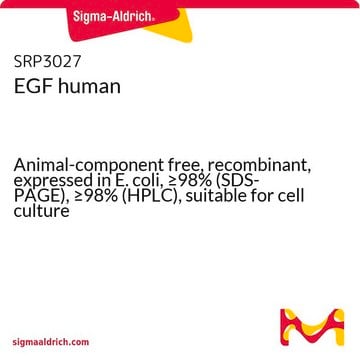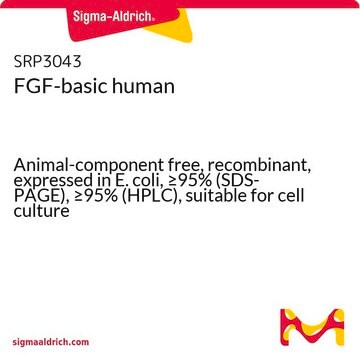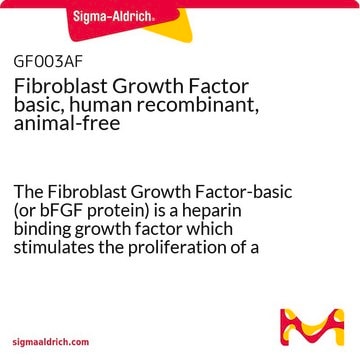SRP4037
FGF-2 human
recombinant, expressed in E. coli, ≥95% (SDS-PAGE), ≥95% (HPLC)
Synonym(s):
FGF-2, Fibroblast Growth Factor-basic, HBGF-2, Prostatropin
Sign Into View Organizational & Contract Pricing
All Photos(1)
About This Item
Recommended Products
biological source
human
recombinant
expressed in E. coli
Assay
≥95% (HPLC)
≥95% (SDS-PAGE)
form
lyophilized
mol wt
~17.2 kDa
packaging
pkg of 50 μg
storage condition
avoid repeated freeze/thaw cycles
impurities
endotoxin, tested
NCBI accession no.
UniProt accession no.
shipped in
wet ice
storage temp.
−20°C
Gene Information
human ... FGF2(2247)
General description
The gene FGF2 (fibroblast growth factor 2) is mapped to human chromosome 4q28. FGF-2 is a basic heparin binding growth factor. The recombinant human FGF-2 is a 17.2kDa protein containing 154 amino acid residues. It is also referred to as BFGF (basic fibroblast growth factor).
Application
FGF-2 human has been used:
- as medium supplement for E9.5 neuroepithelial cell culture
- as a component in the neurobasal growth medium
- in growing embryonic neural stem/progenitor cells (NSPCs) in a 2D culture
FGF2 (fibroblast growth factor 2)-human has been used in endothelial colony assay.
Biochem/physiol Actions
FGF2 (fibroblast growth factor 2, also referred to as BFGF (basic fibroblast growth factor)) interacts with FGFR1 (fibroblast growth factor receptor 1), FGFR2 and FGFR3. It stimulates the proliferation of a wide variety of cells including mesenchymal, neuroectodermal and endothelial cells. FGF2 also determines the fate of neural precursor cells and promotes neuronal axon regeneration. It plays an important role in spinal cord injury repair. FGF2 is known to stimulate angiogenesis and is associated with cancer development. High levels of FGF2 are present in the kidney of children with HIV (human immunodeficiency virus)-renal diseases. The FGF2 mRNA is a target of miRNA miR-503.
Physical form
Lyophilized from a 1 mg/ml solution of 5 mM Tris pH 7.6 plus 150 mM NaCl.
Reconstitution
Centrifuge the vial prior to opening. Avoid freeze-thaw cycles.
Reconstitute in 5 mM Tris, pH 7.6 to a concentration of 0.1-1.0 mg/mL. This solution can then be diluted into other aqueous buffers.
Storage Class Code
11 - Combustible Solids
WGK
WGK 3
Flash Point(F)
Not applicable
Flash Point(C)
Not applicable
Certificates of Analysis (COA)
Search for Certificates of Analysis (COA) by entering the products Lot/Batch Number. Lot and Batch Numbers can be found on a product’s label following the words ‘Lot’ or ‘Batch’.
Already Own This Product?
Find documentation for the products that you have recently purchased in the Document Library.
Customers Also Viewed
Expression of VEGFR-2 and AC133 by circulating human CD34(+) cells identifies a population of functional endothelial precursors.
Peichev M
Blood, 95, 952-958 (2000)
Isolation of Neural Stem Cells from the Embryonic Mouse Hippocampus for in vitro Growth or Engraftment into a Host Tissue
Rybachuk O, et al.
Bio-protocol, 9(4) (2019)
Zinc deficiency causes neural tube defects through attenuation of p53 ubiquitylation
Li H, et al.
Development, 145(24), dev169797-dev169797 (2018)
Role of microRNA?503 in the suppression of osteosarcoma cell proliferation and migration via modulation of fibroblast growth factor 2.
Wu B and Bi W
Molecular Medicine Reports, 12, 7433-7438 (2015)
Cigdem Usul Afsar et al.
International journal of clinical and experimental pathology, 8(9), 9760-9771 (2015-12-01)
Non-small cell lung carcinoma is the leading cause of cancer related to death in the world. Squamous cell lung carcinoma (SqCLC) is the second most frequent histological subtype of lung carcinomas. Recently, growth factors, growth factor receptors, and signal transduction
Our team of scientists has experience in all areas of research including Life Science, Material Science, Chemical Synthesis, Chromatography, Analytical and many others.
Contact Technical Service









